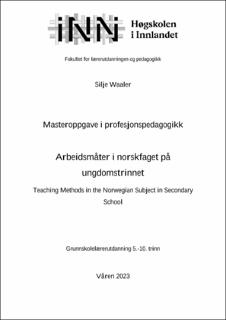| dc.contributor.advisor | | |
| dc.contributor.author | Waaler, Silje | |
| dc.date.accessioned | 2023-07-18T16:10:36Z | |
| dc.date.available | 2023-07-18T16:10:36Z | |
| dc.date.issued | 2023 | |
| dc.identifier | no.inn:inspera:136493732:97413430 | |
| dc.identifier.uri | https://hdl.handle.net/11250/3079791 | |
| dc.description.abstract | Tittelen på denne masteroppgaven er «Arbeidsmåter i norskfaget på ungdomstrinnet». I grunnopplæringen jobber elever og lærere kontinuerlig mot ulike mål. Elevene skal nå kompetansemålene som er forventet for deres alderstrinn, og disse målene nås gjennom ulike arbeidsmåter. Det betyr at arbeidsmåter har en viktig rolle i skolehverdagen og generelt i opplæringen. I den gjeldende læreplanen (LK20) er ikke arbeidsmåter nevnt eksplisitt. Det betyr at valg av arbeidsmåter inngår i lærerens autonomi og profesjonelle skjønn. Denne metodefriheten har vært utgangspunktet for oppgavens problemstilling. Samtidig syns jeg det er interessant å se på hvilke arbeidsmåter norsklærere bruker.
Masteroppgaven er en kvalitativ studie av arbeidsmåter på ungdomstrinnet, med problemstillingen: Hvordan tilpasser og tilrettelegger to ungdomsskolelærere norskundervisningen gjennom ulike arbeidsmåter og digitale verktøy? For å besvare problemstillingen undersøker jeg hvilke arbeidsmåter som er i bruk i undervisningen, hvordan lærerne begrunner valgene av arbeidsmåtene og hvordan digitale verktøy bidrar til muligheter og utfordringer i undervisningen. Temaet i studien blir belyst gjennom teoretiske perspektiver, samt nasjonal og internasjonal forskning.
Empirien i masteroppgaven består av intervjuer og observasjoner av to læreres praksis når de underviser i norskfaget på ungdomstrinnet. Funnene i studien viser at elevenes individuelle arbeid og lærerstyrte klassesamtaler dominerer i undervisningen. Begge lærerne har sterke ønsker om at alle elever skal føle på mestring, og de tilpasser og tilrettelegger derfor arbeidsmåtene for at alle elevene har forutsetninger for å få til noe. Tilpasset opplæringen dreier seg også om at lærerne varierer hvilke arbeidsmåter de legger opp til. Lærerne deler opp undervisningen og varierer mellom arbeidsmåter i undervisningsøktene. Lærerne har et ambivalent forhold til bruk av digitale verktøy. På den ene siden kan digitale verktøy skape utfordringer for elevenes konsentrasjon, mens de på den andre siden fungerer som et hjelpemiddel i elevenes læringsprosesser. Denne studien bidrar til å sette arbeidsmåter i norskundervisningen på ungdomstrinnet i fokus, og kan være et nyttig supplement til tidligere forskning. | |
| dc.description.abstract | The title of this master’s thesis is «Teaching Methods in the Norwegian Subject in Secondary School». The pupils and teachers work continuously towards different goals during the education. The pupils must reach the goals of competence that are expected for their age level, and these goals are reached throught different teaching methods. This means that teaching methods are an important part in everyday school life and in education in general. In the current curriculum (LK20), teaching methods are not mentioned explicitly. This means that the choice of teaching methods is a part of teachers’ autonomy and professional judgement. This freedom of method has been the starting point for this thesis’ topic question.
The Master’s thesis is a qualitative study of the topic of teaching methods at secondary school, wtih the topic question: How do two secondary school teachers adapt and facilitate the teaching in the Norwegian subject through different teaching methods and digital tools? In order to answer the problem, I look into which teaching methods are in use in teaching, how the teachers justify their choice of teaching methods and how digital tools contribute to opportunities and challenges in the choice of teaching methods. The topic of the study is illuminated through theoretical perspectives, as well as national and international research.
The experience in the master’s thesis consist of the interviews and observations of two teachers who teach the Norwegian subject at secondary school. The findings of the study are that individual teaching methods and class discussions dominate the teaching. Both teachers have a strong desire for everyone to feel mastery and therefore adapt and fascilitate the teaching methods so that all pupils have prerequisites to achieve something. Part of the adapted training is also that the teachers cary in the teaching methods they propose. They are concerned with dividing up the teaching so that they can vary between teaching methods in the individual teaching sessions. The teachers have a ambivalent relationship with digital tools, as on the one hand it can create challenges around the pupils’ concentration in the implementation of the teaching methods, but on the other hand it functions as an aid in the pupils’ learning processes. This study helps to put focus on teaching methods in the Norwegian subject at secondary school and can be a useful supplement to previous research. | |
| dc.language | nob | |
| dc.publisher | Inland Norway University | |
| dc.title | Arbeidsmåter i norskfaget på ungdomstrinnet | |
| dc.type | Master thesis | |
